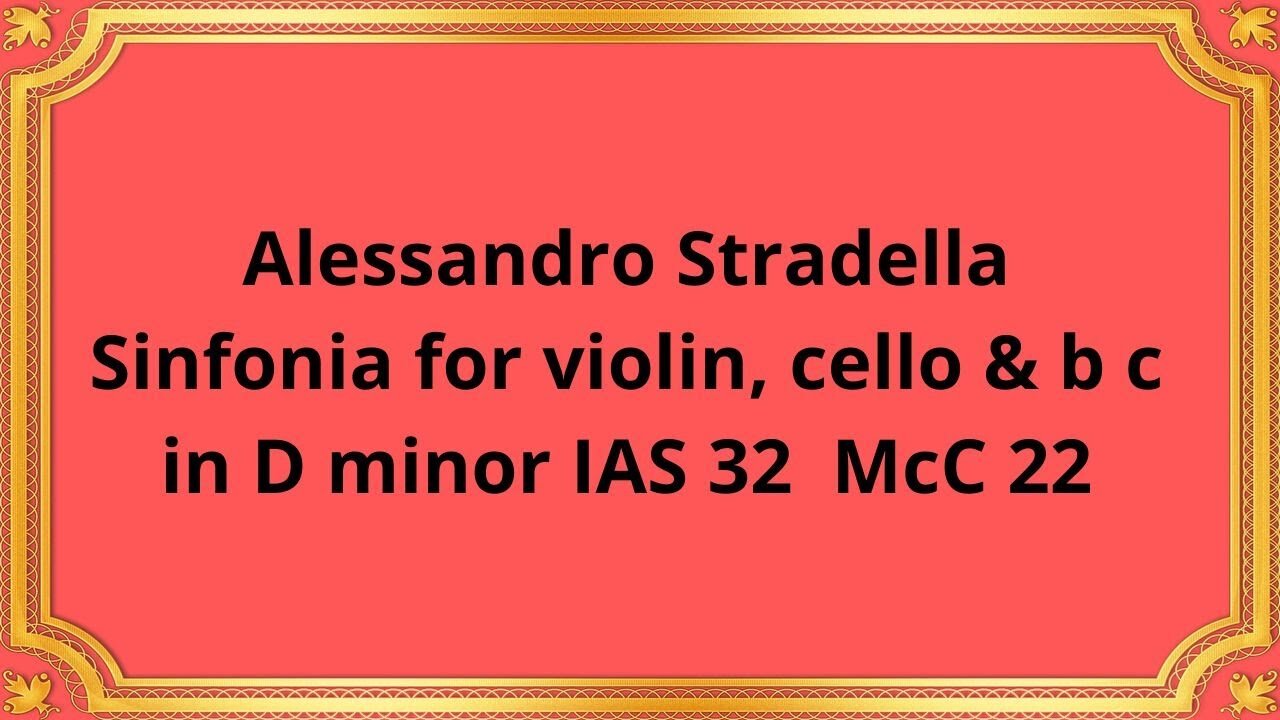Premium Only Content

Alessandro Stradella Sinfonia for violin, cello & b c in D minor IAS 32 McC 22
#AlessandroStradella #Sinfonia #Violin #Cello #BassoContinuo #DMinor #IAS32 #McC22 #ClassicalMusic #MusicalComposition #BaroqueEra #ItalianComposer #InstrumentalMusic
Publication date 1954
Trio di Bolzano
Nunzio Montanari (piano)
Giannino Carpi (violin)
Antonio Valisi (’cello)
Alessandro Stradella, an influential Italian composer of the Baroque era, has left an indelible mark on the world of classical music. Among his notable works, the Sinfonia for Violin, Cello & Basso Continuo in D minor, IAS 32 McC 22, stands as a testament to his compositional prowess.
Composed during the Baroque era, a time of great artistic and musical flourishing, Stradella's Sinfonia reflects the stylistic characteristics and innovations of the period. As an Italian composer, Stradella played a significant role in shaping the musical landscape of his time, and this composition showcases his mastery in combining melody, harmony, and virtuosity.
The Sinfonia for Violin, Cello & Basso Continuo in D minor comprises several movements that showcase Stradella's ability to craft engaging and dynamic instrumental music.
1. Introduction:
The sinfonia begins with a captivating introduction that establishes the key and sets the mood for the piece. Stradella's use of rich harmonies and a driving rhythm immediately captures the attention of the listener, drawing them into the world of the composition.
2. Allegro:
The first movement, marked Allegro, unfolds with a lively and energetic character. The violin and cello engage in a spirited dialogue, showcasing their technical prowess and musical agility. Stradella's use of counterpoint and interplay between the instruments creates a sense of musical conversation and exploration.
3. Adagio:
Following the exuberant Allegro, the Adagio movement provides a contrasting and introspective moment within the sinfonia. The violin and cello take turns expressing poignant and lyrical melodies, accompanied by the basso continuo. Stradella's use of expressive harmonies and ornamentation adds depth and emotional richness to this movement.
4. Allegro finale:
The final movement, marked Allegro, brings the sinfonia to a thrilling conclusion. Stradella's skillful composition and use of virtuosic passages showcase the technical abilities of the violin and cello. The movement combines elements of dance-like rhythms with intricate melodic patterns, creating a sense of excitement and anticipation.
Stradella's Sinfonia for Violin, Cello & Basso Continuo in D minor has had a lasting impact on the world of instrumental music. Its technical brilliance, emotive melodies, and seamless interplay between instruments have influenced subsequent composers and performers. Stradella's ability to blend virtuosity with expressive depth has made this sinfonia a staple in the repertoire of chamber music.
Conclusion:
Alessandro Stradella's Sinfonia for Violin, Cello & Basso Continuo in D minor, IAS 32 McC 22, is a testament to the composer's mastery of Baroque instrumental music. Through its vibrant and dynamic musical structure, the composition showcases Stradella's ability to create engaging dialogues between instruments and evoke a range of emotions. As we continue to appreciate and study this remarkable piece, we gain a deeper understanding of Stradella's contribution to the rich tapestry of classical music.
You have the opportunity to support the channel:
https://destream.net/live/RadSiarAl/donate
https://www.buymeacoffee.com/6355radsiaral
-
 34:12
34:12
inspirePlay
1 day ago $5.73 earned🏆 The Grid Championship 2024 – Cass Meyer vs. Kelly Rudney | Epic Battle for Long Drive Glory!
89.9K8 -
 17:50
17:50
BlackDiamondGunsandGear
16 hours ago $3.11 earnedTeach Me How to Build an AR-15
63.9K6 -
 9:11
9:11
Space Ice
1 day agoFatman - Greatest Santa Claus Fighting Hitmen Movie Of Mel Gibson's Career - Best Movie Ever
121K48 -
 42:38
42:38
Brewzle
1 day agoI Spent Too Much Money Bourbon Hunting In Kentucky
82.2K13 -
 1:15:30
1:15:30
World Nomac
1 day agoMY FIRST DAY BACK in Manila Philippines 🇵🇭
63.9K10 -
 13:19
13:19
Dr David Jockers
1 day ago $11.93 earned5 Dangerous Food Ingredients That Drive Inflammation
82.5K17 -
 1:05:13
1:05:13
FamilyFriendlyGaming
1 day ago $15.97 earnedCat Quest III Episode 8
132K3 -
 10:39
10:39
Cooking with Gruel
2 days agoMastering a Succulent London Broil
84.6K5 -
 22:15
22:15
barstoolsports
1 day agoWhite Elephant Sends Barstool Office into Chaos | VIVA TV
59.7K1 -
 3:30:40
3:30:40
MrNellyGB
22 hours ago🔴LIVE - GRINDING MARVEL RIVALS RANKED! | #RumbleTakeover #RumblePremium
41.1K1